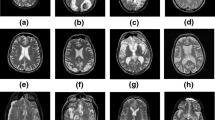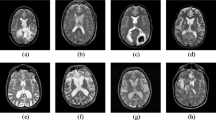Abstract
Brain abnormalities are neurological disorders of the human nervous system that contain biochemical, electrical, and structural changes in the brain and spinal cord. However, such changes produce diverse symptoms like paralysis, amnesia, and muscle weakness. The diagnosis of these abnormalities is crucial for treatment planning in the early stage to limit the progression of diseases. The brain Magnetic Resonance (MR) images are extensively used for treatment planning, but manually diagnosis of MR images is a time-consuming, expensive, and cumbersome task. Hence, in this paper, we have proposed the automated Computer-Aided Diagnosis (CAD) system for classification of brain MR images. These images are skill-stripped for removing the irrelevant tissues that improve the quality of images. We have developed the Fast version of Simplified Pulse-Coupled Neural Network (F-SPCNN) to segment the region of interest. Further, the features are extracted from the segmented images by using the Ripplet Transform (RT). Subsequently, Probabilistic Principal Component Analysis (PPCA) is employed for reducing the dimensionality of features. Finally, Twin Support Vector Machine (TWSVM) is applied for classification of brain MR images. The extensive simulation results on three standard datasets, e.g., DS-66, DS-160, and DS-255, demonstrate that the proposed method achieves better performance than the state-of-the-art methods.











Similar content being viewed by others
Change history
27 July 2021
A Correction to this paper has been published: https://doi.org/10.1007/s11042-021-11116-3
References
Berg H, Olsson R, Lindblad T, Chilo J (2008 Jun 1) Automatic design of pulse coupled neurons for image segmentation. Neurocomputing 71(10–12):1980–1993
Chaplot S, Patnaik LM, Jagannathan NR (2006 Jan 1) Classification of magnetic resonance brain images using wavelets as input to support vector machine and neural network. Biomed Signal Process Control 1(1):86–92
Chen WJ, Shao YH, Li CN, Liu MZ, Wang Z, Deng NY (2020 Feb 1) Projection twin support vector machine for pattern classification. Neurocomputing 376:10–24
Das S, Chowdhury M, Kundu MK (2011) Medical image fusion based on ripplet transform type-I. Prog Electromagn Res 30:355–370
Das S, Chowdhury M, Kundu MK (2013) Brain MR image classification using multiscale geometric analysis of ripplet. Prog Electromagn Res 137:1–7
El-Dahshan ES, Hosny T, Salem AB (2010 Mar 1) Hybrid intelligent techniques for MRI brain images classification. Digit Signal Process 20(2):433–441
El-Dahshan ES, Mohsen HM, Revett K, Salem AB (2014 Sep 1) Computer-aided diagnosis of human brain tumor through MRI: a survey and a new algorithm. Expert Syst Appl 41(11):5526–5545
Gong B, Shi J, Ying S, Dai Y, Zhang Q, Dong Y, An H, Zhang Y (2018 Dec 3) Neuroimaging-based diagnosis of Parkinson’s disease with deep neural mapping large margin distribution machine. Neurocomputing 320:141–149
Gupta Y, Lama RK, Lee SW, Kwon GR (2020 Nov) An MRI brain disease classification system using PDFB-CT and GLCM with kernel-SVM for medical decision support. Multimed Tools Appl 79(43):32195–32224
Harvard Medical School. http://med.harvard.edu/AANLIB/
Juliet S, Rajsingh EB, Ezra K (2016 Feb 1) A novel medical image compression using Ripplet transform. J Real-Time Image Proc 11(2):401–412
Khemchandani R, Chandra S (2007 Mar 19) Twin support vector machines for pattern classification. IEEE Trans Pattern Anal Mach Intell 29(5):905–910
Khemchandani R, Saigal P, Chandra S (2018 Oct 1) Angle-based twin support vector machine. Ann Oper Res 269(1–2):387–417
Kurokawa H, Kaneko S, Yonekawa M (2008) A color image segmentation using inhibitory connected pulse coupled neural network. In: International conference on neural information processing. Springer, Berlin, Heidelberg, pp 776–783
Liu S, Li L, Peng Y, Qiu G, Lei T (2017 Jan 12) Improved sparse representation method for image classification. IET Comput Vis 11(4):319–330
Mangasarian OL, Wild EW (2005 Nov 21) Multisurface proximal support vector machine classification via generalized eigenvalues. IEEE Trans Pattern Anal Mach Intell 28(1):69–74
Nayak DR, Dash R, Majhi B (2016 Feb 12) Brain MR image classification using two-dimensional discrete wavelet transform and AdaBoost with random forests. Neurocomputing 177:188–197
Nayak DR, Dash R, Majhi B, Prasad V (2017 Dec 1) Automated pathological brain detection system: a fast discrete curvelet transform and probabilistic neural network based approach. Expert Syst Appl 88:152–164
Nayak DR, Dash R, Majhi B (2018 Feb 1) Pathological brain detection using curvelet features and least squares SVM. Multimed Tools Appl 77(3):3833–3856
Piantadosi G, Marrone S, Fusco R, Sansone M, Sansone C (2018 Aug 6) Comprehensive computer-aided diagnosis for breast T1-weighted DCE-MRI through quantitative dynamical features and spatio-temporal local binary patterns. IET Comput Vis 12(7):1007–1017
Shanker R, Bhattacharya M (2017) Brain tumor segmentation of normal and pathological tissues using K-mean clustering with fuzzy C-mean clustering. In: European congress on computational methods in applied sciences and engineering. Springer, Cham, pp 286–296
Shanker R, Bhattacharya M (2019) Brain tumor segmentation of normal and lesion tissues using hybrid clustering and hierarchical centroid shape descriptor. Comput Methods Biomech Biomed Eng Imaging Vistion:1–4
Shanker R, Bhattacharya M (2020 Apr 1) An automated computer-aided diagnosis system for classification of MR images using texture features and gbest-guided gravitational search algorithm. Biocybern Biomed Eng 40(2):815–835
Shi J, Xue Z, Dai Y, Peng B, Dong Y, Zhang Q, Zhang Y (2018 Dec 24) Cascaded multi-column RVFL+ classifier for single-modal neuroimaging-based diagnosis of Parkinson’s disease. IEEE Trans Biomed Eng 66(8):2362–2371
Tanveer M (2015 Feb 1) Robust and sparse linear programming twin support vector machines. Cogn Comput 7(1):137–149
Tanveer M, Sharma A, Suganthan PN (2019 Aug 1) General twin support vector machine with pinball loss function. Inf Sci 494:311–327
Tipping ME, Bishop CM (1999) Probabilistic principal component analysis. J R Stat Soc Series B (Stat Methodol) 61(3):611–622
Ural B, Özışık P, Hardalaç F (2019) An improved computer based diagnosis system for early detection of abnormal lesions in the brain tissues with using magnetic resonance and computerized tomography images. Multimed Tools Appl:1–22
Wang C, Wang W (2006 May 8) Links between PPCA and subspace methods for complete Gaussian density estimation. IEEE Trans Neural Netw 17(3):789–792
Wang S, Zhang Y, Dong Z, Du S, Ji G, Yan J, Yang J, Wang Q, Feng C, Phillips P (2015 Jun) Feed-forward neural network optimized by hybridization of PSO and ABC for abnormal brain detection. Int J Imaging Syst Technol 25(2):153–164
Wang S, Du S, Atangana A, Liu A, Lu Z (2018 Feb 1) Application of stationary wavelet entropy in pathological brain detection. Multimed Tools Appl 77(3):3701–3714
Wei S, Hong Q, Hou M (2011 Apr 1) Automatic image segmentation based on PCNN with adaptive threshold time constant. Neurocomputing 74(9):1485–1491
Xu J, Yang L, Wu D (2010) Ripplet: a new transform for image processing. J Vis Commun Image Represent 21(7):627–639
Yang G, Zhang Y, Yang J, Ji G, Dong Z, Wang S, Feng C, Wang Q (2016 Dec 1) Automated classification of brain images using wavelet-energy and biogeography-based optimization. Multimed Tools Appl 75(23):15601–15617
Zhang YD, Wu L (2012) An MR brain images classifier via principal component analysis and kernel support vector machine. Prog Electromagn Res 130:369–388
Zhang YD, Wang S, Wu L (2010) A novel method for magnetic resonance brain image classification based on adaptive chaotic PSO. Prog Electromagn Res 109:325–343
Zhang Y, Dong Z, Wu L, Wang S (2011 Aug 1) A hybrid method for MRI brain image classification. Expert Syst Appl 38(8):10049–10053
Zhang YD, Wu L, Wang S (2011) Magnetic resonance brain image classification by an improved artificial bee colony algorithm. Progr Electromagn Res 116:65–79
Zhang Y, Dong Z, Liu A, Wang S, Ji G, Zhang Z, Yang J (2015 Dec 1) Magnetic resonance brain image classification via stationary wavelet transform and generalized eigenvalue proximal support vector machine. J Med Imaging Health Inform 5(7):1395–1403
Zhang Y, Wang S, Sun P, Phillips P (2015 Jan 1) Pathological brain detection based on wavelet entropy and Hu moment invariants. Bio-med Mater Eng 26(s1):S1283–S1290
Zhang Y, Dong Z, Wang S, Ji G, Yang J (2015 Apr) Preclinical diagnosis of magnetic resonance (MR) brain images via discrete wavelet packet transform with Tsallis entropy and generalized eigenvalue proximal support vector machine (GEPSVM). Entropy 17(4):1795–1813
Zhang Y, Sun Y, Phillips P, Liu G, Zhou X, Wang S (2016 Jul 1) A multilayer perceptron based smart pathological brain detection system by fractional Fourier entropy. J Med Syst 40(7):173
Zhang YD, Zhao G, Sun J, Wu X, Wang ZH, Liu HM, Govindaraj VV, Zhan T, Li J (2018 Sep 1) Smart pathological brain detection by synthetic minority oversampling technique, extreme learning machine, and Jaya algorithm. Multimed Tools Appl 77(17):22629–22648
Author information
Authors and Affiliations
Corresponding author
Additional information
The original online version of this article was revised: All equations contain added data “aligned” and equations 16 and 18 are incomplete. The references were also not in alphabetical order.
Rights and permissions
About this article
Cite this article
Shanker, R., Bhattacharya, M. Automated Diagnosis system for detection of the pathological brain using Fast version of Simplified Pulse-Coupled Neural Network and Twin Support Vector Machine. Multimed Tools Appl 80, 30479–30502 (2021). https://doi.org/10.1007/s11042-021-10937-6
Received:
Revised:
Accepted:
Published:
Issue Date:
DOI: https://doi.org/10.1007/s11042-021-10937-6




